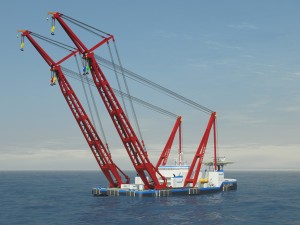Scaldis reveals official calling name
Scaldis has revealed the official calling name GULLIVER for their new DP II heavy lift vessel.
During the design phase of the vessel Scaldis used the provisional calling name RAMBIZ 4000 referring to the lifting capacity. The vessel’s keel laying ceremony took place on Saturday 27 February 2016 at the Hong Qiang shipyard near Shanghai. Following this event, now the name of the vessel is revealed. The vessel’s name refers to Gulliver from Gulliver’s Travels.
The contract for the construction and delivery of the ship was signed on 29th January 2015. The design was drawn up in-house in cooperation with Vuyk Engineering Rotterdam, part of Royal IHC. Delivery is scheduled for spring 2017 in Europe. The vessel is build under full responsibility and coordination of Royal IHC in Qidong and finished at Huisman in Xiamen, both of which are located in the People’s Republic of China.
The ship is ordered to further support and expand the services, including the installation of offshore infrastructures and decommissioning-deconstruction activities for the oil and gas industry as well as the installation of offshore wind farms. The ship can also be used for any type of marine related heavy lifting work in challenging situations, such as the construction of bridge components and clearing subsea obstacles. The provision of a helipad in combination with accommodation for 78 people means Scaldis is capable of providing a varied range of additional services.
The new crane ship has two Huisman cranes each with a lifting capacity of 2,000 tons. The ship also has extra carrying capacity of 3,000 tons. The cranes can be moved by 25m on the ship. This allows the deck to be used to transport and then relocate cargo at a later stage. The ship and the cranes are an integrated design which allows the maximum load to be hoisted in significant wave heights of up to 1.5m. In these circumstances, the freeboard is not less than 3.0m anywhere on the vessel. In standby or transport modes, significant wave height can be as much as 7.0m. It is also worth noting that the maximum load can be lifted in water depths of around 5.0m.
The four azimuth thrusters and the DP II system allow installation work to be conducted in deeper water without the use of anchors. This guarantees flexibility and efficiency and also means that work can be carried out in zones where many pipelines and cables already lie on the bed, for example. The crane ship is also equipped with four main working anchors and winches and four secondary devices.
The powerful and rapid ballast system can follow the hoisting operation exactly, allowing jobs to be completed quickly and continuously. The ship will be equipped with a so-called ‘moonpool’ for the purposes of operating a separate ROV (Remotely Operated Vehicle) for inspecting and supervising installation work on the seabed. Finally, the presence of heavy fenders allows containers to be loaded/unloaded at sea.







